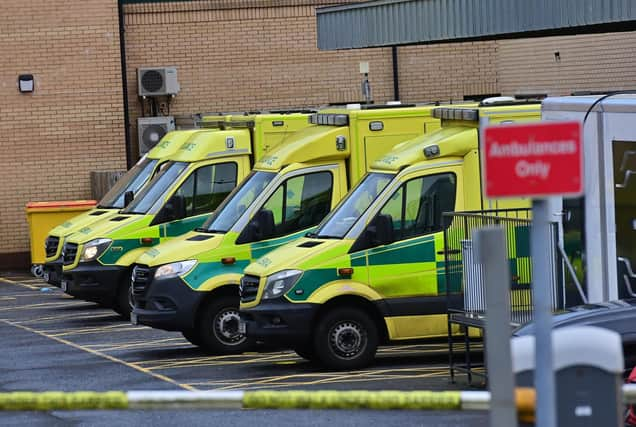Northern Ireland hospital waiting lists: Number of people waiting for first hospital appointment rises by 185% in under a decade


Comptroller and Auditor General, Dorinnia Carville, has published a report outlining the critical situation within the health service as it struggles with rising waiting lists for elective care.
Northern Ireland has the worst hospital waiting lists in the UK, with more than a quarter of the population waiting for an inpatient or outpatient appointment.
Advertisement
Hide AdAdvertisement
Hide AdThe Department of Health in the region is grappling with a multimillion-pound budget shortfall.
Unlike unscheduled treatment, elective care is planned in advance, generally following referral from primary care professionals
It involves initial specialist clinical assessment and, if required, subsequent care, including diagnostic tests, surgery, and other inpatient treatments.
The report describes "alarming growth" in both the number of patients on elective care waiting lists, and the length of time they wait for assessment and treatment.
Department of Health statistics show that:
Advertisement
Hide AdAdvertisement
Hide Ad- Between March 2014 and March 2023, the total numbers waiting for either an initial outpatient appointment, inpatient treatment, or a diagnostic test have risen by 185% (from around 244,000 patients to 696,000 patients);
- At March 2023, 49% of patients (around 197,000) were waiting over a year for an initial outpatient appointment, compared to 21% in March 2017;
- At March 2023, 54% of patients (around 64,000) were waiting more than a year for inpatient treatment, compared to 14% at March 2017; and
- At March 2023, 46,500 patients (27%) were waiting over 26 weeks for a diagnostic test compared to 9,700 (14%) at March 2017.
Advertisement
Hide AdAdvertisement
Hide AdThe report said a growing gap between rising population demand for care and available funding has significantly contributed to lengthy waiting times.
While the report acknowledged that the Covid-19 pandemic exacerbated the challenges, it also noted that the deterioration in waiting times has been longstanding.
The report also said that a failure to secure longer-term budgets for Stormont civil service departments has persistently hindered the development of more sustainable funding and planning.
A five-year departmental plan to substantially reduce waiting times had been estimated to cost up to £909 million to implement fully - in practice, only £136.5 million was made available (with a further £56 million allocated from Confidence and Supply Agreement funding).
Advertisement
Hide AdAdvertisement
Hide AdThe report said under an updated framework, an estimated £707 million was required just to ensure that by 2026 waiting times do not exceed a year for either an outpatient appointment or inpatient treatment, but the department has now acknowledged that these latest targets cannot be met.
The report does note some limited progress made by the health and social care sector in developing dedicated elective care to increase productivity and protect services from unscheduled care pressures, welcoming the opening of Northern Ireland's first two dedicated regional day care centres at Lagan Valley and Omagh hospitals and varicose vein and cataract centres.
It said that three elective overnight stay centres have also been introduced to boost capacity.
However, it said that evidence suggests Northern Ireland remains behind the rest of the UK in developing dedicated elective care capacity.
Advertisement
Hide AdAdvertisement
Hide AdThe report also said that Northern Ireland has also been comparatively slow in developing more transparent performance reporting which measures the total time patients wait (from outpatient referral to completion of treatment), with the rest of the UK having introduced these over a decade ago.
Ms Carville said: "Despite the remarkable efforts of HSC staff over recent years in trying to cope with rising patient demand, the deterioration in elective waiting time performance is stark, with latest available figures estimating around 26% of the total Northern Ireland population (over 500,000 people) were on an outpatient or inpatient waiting list.
"Lengthy waits place patients at risk of developing debilitating and complex conditions, potentially requiring more expensive treatment.
"Patients' mental health and quality of life can also suffer to a point where many risk developing serious conditions.
Advertisement
Hide AdAdvertisement
Hide Ad"As a result, reduced waiting times are essential to improve both patient health and public finances.
"The health system has been operating within mainly tight and short-term financial environments."
She added: "After several previous failed waiting time strategies, it is hugely disappointing that the department has acknowledged that the Elective Care Framework targets for 2026 cannot be met, less than halfway into its lifecycle.
"However, unless and until a longer-term, sustainable funding framework to enable health service transformation is established, the department will likely have to address the most pressing clinical waits through available short-term funding.
Advertisement
Hide AdAdvertisement
Hide Ad"This approach is totally unsuitable and almost certainly stores up huge problems for the future.
"The department and the wider health and social care sector must continue to plan how any additional resources, which might become available, can be used to maximum effect and successfully drive transformation."